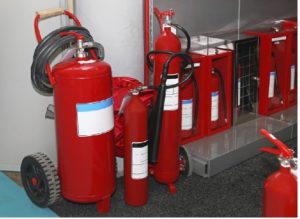
Here are seven different types of fire extinguishers and what fires they put out.
When thinking about fire safety, your home or business has to be ready for anything. This includes having the right fire extinguisher. Fire extinguishers can help minimize the impact of fires until you can get help from the fire department. There are many types of fires, and as such, there are many varieties of fire extinguishers. Here are seven different types of fire extinguishers and what fires they put out.
Water & Foam
Water foam fire extinguishers are best used on class A fires, which are started using standard combustible items like paper and wood. The water from the extinguisher reduces the heat from the fire, and the foam removes the oxygen, which derives the fire of its power.
Carbon Dioxide
This fire extinguisher is best used on class B fires (fires started with flammable liquids and gasses) and class C fires (fires started through energized electrical supplies). Carbon dioxide fire extinguishers replace the oxygen in fires with carbon dioxide, as the name may imply. The gas is able to be contained under pressure, and a cold discharge is formed to get rid of the fire’s heat.
Dry Chemical
Dry chemical fire extinguishers can be used for either Class A, B or C fires. They disrupt the chemical reactions taking place in the fire. Since they are so versatile, they are among the most commonly used fire extinguishers around.
Wet Chemical
These extinguishers are helpful in putting out Class K fires (kitchen fires). They do this by getting rid of the heat of the fire, then creating a barrier that blocks the oxygen from the fuel. This stops the fire from reigniting.
Clean Agent
Also known as Halogenated fire extinguishers, these are used to handle class B and C fires. They accomplish this by using halon agents that disrupt a fire’s chemical reactions. This deprives the fire of its power, causing it to fizzle out.
Dry Powder
Dry powder fire extinguishers function similarly to dry chemical variants because the powder separates the oxygen from the fuel. The difference is that this extinguisher is used for class D fires, which get started by flammable metals.
Water Mist
These fire extinguishers only serve to remove the heat from fires. For this reason, they are used only for class A fires and class C fires.
KEEP YOURSELF SAFE WITH ANDERSON FIRE PROTECTION, INC.
Anderson Fire Protection, Inc. has the expertise and skill to help your home or commercial property for all your fire protection needs. We have been working in the Maryland, Northern Virginia, Southern Pennsylvania, and Washington, D.C. areas for over 25 years. We are known for our top-notch customer service and high-quality results. If you are ready for fantastic fire prevention and protection services, from fire sprinkler installation to fire alarm design and to consult, give us a call at (410) 796-4915 or visit us online.
